

| Journal Home Page | Apollo 11 Home Page |
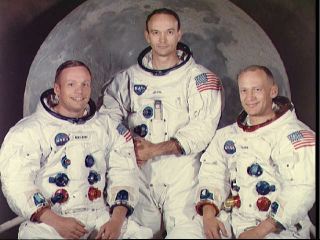
Apollo 11 Official Crew Portrait
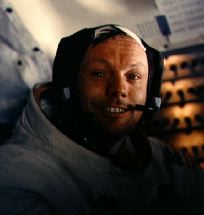
Personal: Born August 5, 1930, Wapakoneta, Ohio. Married, two children.
Education: B.S. in aeronautical engineering, Purdue University, 1955. M.S. in aerospace engineering, University of Southern California, 1970.
Spaceflights: Command pilot, Gemini 8 (1966). Commander, Apollo 11 (1969).
As an aviator in the U.S. Navy, Neil flew 78 mission in Korea. He received a B.S degree in Aeronautical Engineering from Purdue University in 1955 and then became a civilian test pilot with the National Advisory Committee for Aeronautics (NACA). He made seven flights in the X-15 program (1960 photo), reaching an altitude of 207,500 feet. He was chosen in the second group of astronauts in 1962 and was assigned as backup command pilot for Gemini 5, command pilot for Gemini 8, backup command pilot for Gemini 11, backup commander for Apollo 8, and commander for Apollo 11 (first man to walk on the Moon). He was Deputy Associate Administrator for Aeronautics at NASA from July 1970 until August 1971, when he resigned to become Professor of Aeronautical Engineering at the University of Cincinnati. Served on the National Commission on Space from 1985 to 1986 and on the Presidential Commission on the Space Shuttle Challenger Accident in 1986.
Neil died on 25 August 2012 due to complications from blocked coronary arteries. He was 82. His family issued a public statement on that day. Tributes from former colleagues appeared in the days that followed.

Personal: Born October 31, 1930, Rome, Italy. Married, three children.
Education. B.S., U.S. Military Academy, 1952.
Spaceflights: Pilot, Gemini 10 (1966). Command module pilot, Apollo 11 (1969).
Mike graduated from the U.S. Military Academy in 1952. He then joined the U.S. Air Force as a fighter pilot. He later graduated from the USAF Experimental Flight Test Pilot School, where he participated in a course dealing with the basics of spaceflight. He was about to return to fighter operations when he was chosen in the third group of astronauts in 1963. He served as backup pilot for Gemini 7, pilot for Gemini 10, and command module pilot for Apollo 11. He had been assigned to Apollo 8 but was removed to undergo surgery. After Apollo 11, he resigned from NASA in January 1970 and was appointed Assistant Secretary of State for Public Affairs. Became Director of the National Air and Space Museum at the Smithsonian Institution in April 1971 and was promoted to Under Secretary of the Smithsonian in April 1978. Retired from the Air Force with the rank of Major General. Became Vice President, Field Operations, Vought Corporation, Arlington, Virginia, in February 1980. Later formed Michael Collins Associates, a Washington, D.C. consulting firm.Has written numerous articles and two books, Carrying the Fire and Liftoff, as well as a children's book, Flying to the Moon and Other Strange Places.
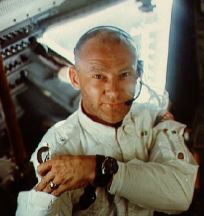
Personal: Born Edwin Eugene Aldrin, Jr., January 20, 1930, Montclair, New Jersey. Later, legally changed his name to "Buzz Aldrin". Married, three children (from a previous marriage).
Education: B.S., U.S. Military Academy, 1951. Ph.D. in astronautics, Massachusetts Institute of Technology, 1963. A read-only copy of his Ph.D. thesis, Line-of-Sight Guidance Techniques for Manned Orbital Rendezvous is available online.
Spaceflights: Pilot, Gemini 12 (1966). Lunar module pilot, Apollo 11 (1969).
Graduated in 1951 from the U.S. Military Academy at West Point with a degree in mechanical engineering. As an Air Force fighter pilot, he flew 66 combat missions in Korea. Chosen with the third group of astronauts in 1963. Was backup pilot for Gemini 9, pilot on Gemini 12, backup command module pilot for Apollo 8, and lunar module pilot for Apollo 11 (second man to walk on the Moon). Resigned from NASA in July 1971 to become Commandant of the Aerospace Research Pilot's School at Edwards AFB, California. Retired from the Air Force in 1972 and became a consultant for the Comprehensive Care Corporation, Newport Beach, California. As of 2005, Buzz resided in southern California and lectured and consulted on space sciences with Starcraft Enterprises. Has authored two books, Return to Earth and Men From Earth.
Charles Moss Duke, Lt. Col., USAF
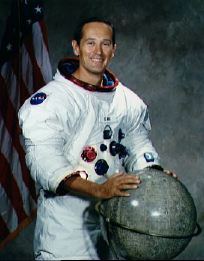
Duke was born in Charlotte, North Carolina on October 3, 1935. He graduated from the US. Naval Academy in 1957 and then joined the U.S. Air Force which had not yet graduated a class of young officers from its own Academy. After completion of flight training, he served as a fighter interceptor pilot in Germany, and, then, attended the Massachusetts Institute of Technology, receiving a Master's Degree in Aeronautics in 1964. The following year he graduated from the Air Force Aerospace Research Pilot School and was serving as an instructor when, in April 1966, he was one of 19 pilots selected in the fifth group of astronauts. He served as CapCom during the Apollo 11 landing and as Lunar Module Pilot with Young on the backup crews for Apollo 13 and 17 and on the Apollo 16 prime crew. Duke retired from the Astronaut Corps in 1975 and became active in private business and as a Christian lay witness. He achieved the rank of Brig. Gen. in the USAF Reserves.
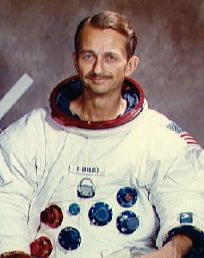
Personal: Born November 22, 1930, Enid, Oklahoma. Married, four children.
Education: B.S. in electrical engineering, University of Oklahoma, 1953. M.S., 1957, and Ph.D., 1960, both in electrical engineering from Stanford University.
Spaceflights: Science pilot, Skylab 3 (1973). Mission specialist, STS-9 (1983).
Chosen with the fourth group of astronauts in 1965. Garriott served as Post-landing and Goodnight CapCom on Apollo 11. Served as the Program Scientist for the Space Station Program Office at Johnson Space Center prior to his retirement from NASA. Was Vice President of Space Programs at Teledyne Brown Engineering, Huntsville, Alabama, but left in 1993 to form Immutherapeutics Inc., also in Huntsville.
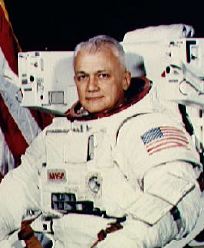
Personal: Born June 8, 1937, Boston, Massachusetts. Married, two children.
Education: B.S., U.S. Naval Academy, 1958. M.S. in electrical engineering, Stanford University, 1965. M.B.A., University of Houston at Clear Lake, 1987.
Spaceflights: Mission specialist, STS 41-B (1984) and STS-31 (1990).
Chosen with the fifth group of astronauts in 1966. Served as EVA CapCom on Apollo 11 and EVA-1 and LM Launch CapCom on Apollo 14. Was backup pilot for Skylab 2 and a mission specialist on STS 41-B and on STS-31, which deployed the Hubble Space Telescope. After resigning from NASA in 1990 and retiring from the Navy, he worked at Martin Marietta Astronautics Co., Denver, Colorado.
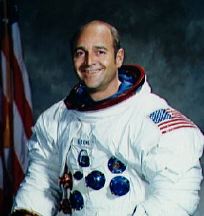
Evans was born November 10, 1933 in St. Francis, Kansas. He was trained as an engineer at the University of Kansas and received a Master's Degree in Aeronautical Engineering from the U.S. Naval Postgraduate School in 1964. Evans was selected as a member of the fourth group of pilot-astronauts in April 1966. At the time of his selection, he was flying combat operations in the South China Sea - from the aircraft carrier USS Ticonderoga - having previously served as a combat flight instructor. He served on the support crew for Apollo 7 and as the Apollo 11 LM Launch CapCom before his assignment to the Apollo 14 backup crew and, then, Apollo 17 as Command Module Pilot. After his lunar flight, Evans served as backup Command Module Pilot for the 1975 Apollo-Soyuz joint flight and then transferred to the Shuttle program prior to his retirement from NASA in 1977. He retired from the Navy with the rank of Captain. He worked as Executive Vice-President of Western America Energy Corporation in Scottsdale, Arizona until 1978, then as Manager, Space Systems Marketing for Sperry Flight Systems, Phoenix, Arizona, and later as a marketing consultant. He died of a heart attack in Scottsdale, Arizona, April 7, 1990.
| Journal Home Page | Apollo 11 Home Page |